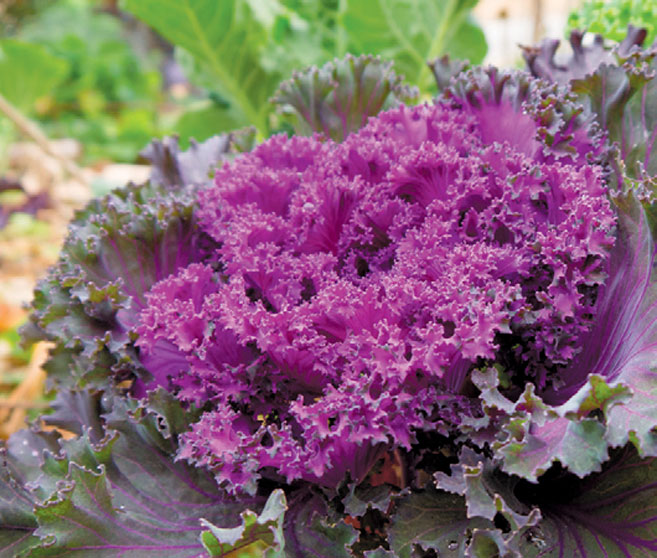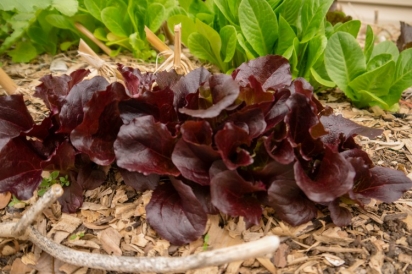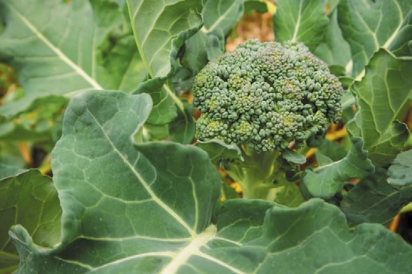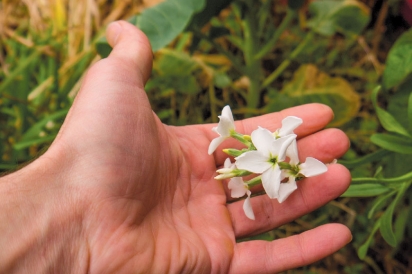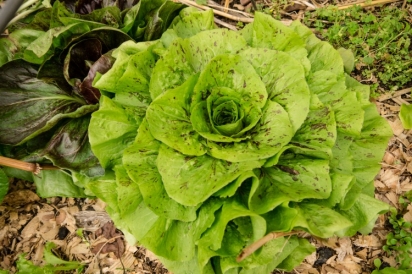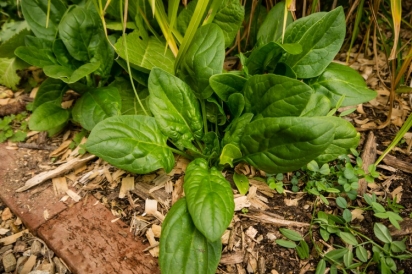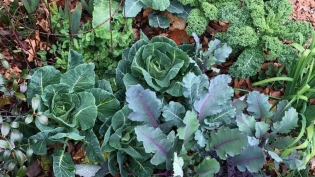Winter Garden
The gardening experts at Tyrant Farms share tips for growing a home garden in even the coldest winter months.
The temperatures are in the single digits, unusually low for Upstate South Carolina. The week’s weather forecast shows we can expect highs in the teens over the next few days. The dreary, frigid weather and muted brown-grey coloration of the dormant forest visible through our windows are enough to dim even the most upbeat mood.
My wife and I bundle up, grab our harvest basket, and head out the front door to our garden beds. Our eyes squint as a gust of wind seems to plunge a thousand frozen needles into the surface of our faces. A few steps later we arrive at our intended destination. We pull back the covering on one of our “low tunnels” (wire frames covered with a transparent sheet of polyethylene) to reveal a verdant strip of assorted vegetables below.
Spinach, mache, chard, kale, cilantro, carrots, chickweed, arugula, choy, cabbage and other cold weather crops are happily growing in this winter oasis. Our moods lift at the sight of living edible plants, awash in a rainbow of color. We harvest quickly so as not to let too much cold air under our tunnels, filling our basket with enough greens for a large dinner salad.
A short while later, happily munching on our freshly harvested bounty, we delight in the wonderful flavors of our greens. Interestingly, our cool weather garden plants pump higher concentrations of sugar into their cells during the winter months, serving as a protective antifreeze against the cold. All the other nutrients in the plant are still present, so the slightly elevated sugar levels simply mean a more delectable meal for us.
WHY WINTER?
Escaping the winter blues and enjoying especially flavorful produce aren’t the only reasons to garden in the cold months. Plant pests and diseases and biting insects like mosquitoes are virtually non-existent during the winter.
Also, due to cool temperatures, soil evaporation is significantly reduced, so garden irrigation needs are minimal. Any time rain is forecast, we pull the covers off of our low tunnels. Rain once every 7-14 days provides all the irrigation we need for our mature plants. We also remove the cover on our tunnels when temperatures are over 50°F, since temperatures underneath the polyethylene tunnels can be 10- 20 degrees higher than outdoor temperatures on sunny days. This ensures that the cool weather-loving plants underneath don’t get too hot, which will trick them into thinking spring has arrived and it’s time to make flowers and seeds–the final stage of an annual plant’s life cycle.
Although this might sound like more than you’d like to deal with to grow fresh organic produce when it’s freezing cold outside, it’s actually quite simple (even enjoyable) once you’ve attained the requisite knowledge and it’s become part of your routine. To us, cold weather gardening is more than worth the minimal hassle. We feel more tuned in to our planet’s continual journey around the sun and also get to enjoy the myriad psychological and physical health benefits associated with gardening, not just in the warm months, but throughout all twelve months of the year.
Not to mention, knowing where our food came from and how it was grown is much easier when it comes from our own yard. Our vegetables’ carbon footprint is about 30 steps and we tend to treat our labor force humanely.
Now, we fully acknowledge that low tunnels covered in polyethylene aren’t the most cosmetically attractive addition to a home landscape, hence the reason ours are tucked away out of view in our backyard. However, our edible landscape extends into our front and side yards, in plain view of the neighbors. What to do?
Thankfully, there are plenty of attractive edible plants that can survive – or even thrive – through winter freezes without any additional protection from the cold. We’ve had spinach, cilantro, pansies and violas (yes, they’re edible), collard greens, chickweed, parsley, claytonia and Austrian winter peas (our favorite winter green is their pea shoots/leaves) survive uncovered into single digit temperatures. The same is true for select varieties of kale bred for extreme cold tolerance. These plants are ideal for an edible landscape or public-facing winter garden since you won’t typically need to cover them. Keep in mind that freezing temperatures will inhibit their growth, so covering them when temps dip below freezing will lead to larger, more frequent harvests.
Other cool weather plants might not survive a deep freeze but will tolerate frosts. Some of our favorite frost-tolerant species are root veggies, such as beets, turnips, carrots, parsnips and rutabagas (most of these can technically survive sustained freezing temps, but they’ll die back to their roots and go dormant until temperatures warm in the late winter). Other favorites include broccoli, bok choy, cabbage, chicory, rapini, lettuce, mustard greens, bok choy, komatsuna and Astro arugula. These are the plants that we’ll grow uncovered during the cool months of fall and late winter, but only grow under our low tunnels in the backyard if we want to grow them through the coldest months of mid-winter.
START FROM SEED
Seed starting is another skill you may want to master if you plan to become good at winter gardening. When we first started gardening many years ago, we were terrible at seed starting and killed most of what we tried to grow. After a couple more seasons of trial and error coupled with absorbing advice from experts, we were able to master the task.
Knowing how to start seeds allows you access to a whole world of interesting and unusual plants that you’ll never find at your local garden center. Not to mention, for the price of a single vanilla variety seedling at a garden center, you can buy an entire pack of interesting heirloom seeds. Plus, there’s something downright magical about taking a tiny speck-sized seed, watching it sprout, and growing it all the way to maturity. In our opinion, this is an essential life skill like learning to drive that everyone should know how to do–if nothing else, you’ll realize vegetables don’t actually come from a can or grow in a grocery store.
When it comes to cool season gardening, being good at seed starting allows you to get a big jump on the season. We start most of our fall seeds indoors in early-mid July and transplant them outdoors underneath our waning summer annuals in early- mid September. As the temperatures cool and we start to trim out what’s left of our summer garden plants, a lush understory of fall veggies is there and ready to begin harvesting. This technique, known as succession planting, allows us to get continual harvests from the same garden beds throughout the year. Contrary to popular belief, your soil does not need to “rest,” aka lay fallow. In fact, the trillions of microbes that comprise and create soil actually benefit from having living roots present throughout the year (the roots feed them and they feed the roots), which is one of the many reasons that more commercial farmers are now using “cover crops” during the winter. To maintain an ideal equilibrium of beneficial soil microbes in your garden soil, we recommend placing a big scoop of worm castings or compost into the your seedlings’ holes any time you’re planting or top-dressing your beds with 2” of worm castings or compost twice per year in the spring and fall.
Since it might be a bit late to start a winter garden this year, we’d suggest you plan to start your first cool weather garden in late winter-early spring and carry that knowledge forward with you into next fall and winter. The world’s most delicious and mood-boosting veggies are waiting for you when you arrive at that destination, so go get started now!


